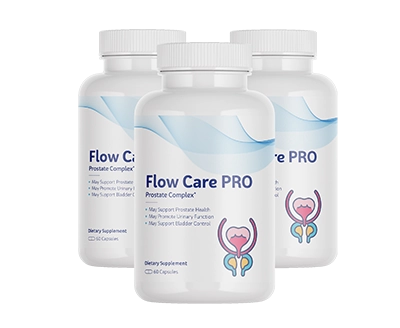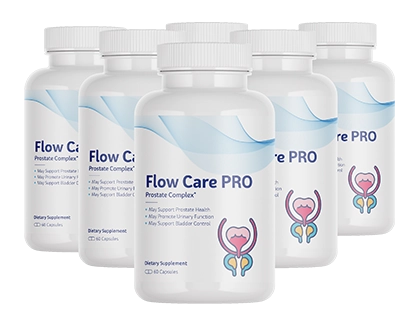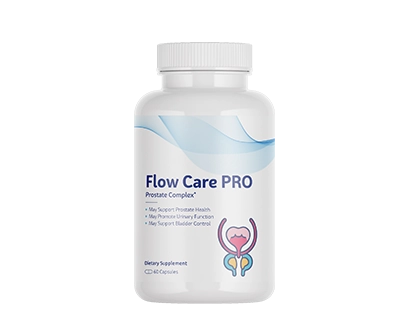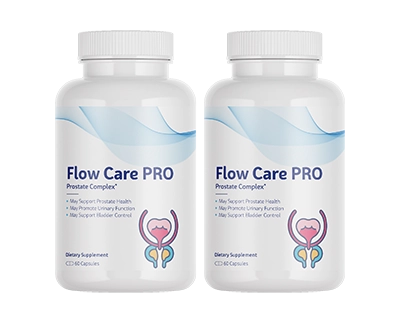Type 2 Diabetes Breakthrough • December 2025
Type 2 Diabetes Breakthrough • December 2025
Breaking Medical Report:
Harvard Study Exposes the Hidden Cause of Prostate Enlargement
IMPORTANT UPDATE: Make sure your sound is ON.
May take up to 10 seconds to load...
Scientific References






Flow Care PRO is not endorsed by, sponsored by, or affiliated with any of these organizations
- Wang, X., Ha, D., Yoshitake, R., Chan, Y. S., Sadava, D., & Chen, S. (2021). Exploring the biological activity and mechanism of xenoestrogens and phytoestrogens in cancers: Emerging methods and concepts. [Editor: P. Chieffi]. Department of Cancer Biology, Beckman Research Institute, City of Hope. https://pmc.ncbi.nlm.nih.gov/articles/PMC8395949/
- Toppari, J., Larsen, J. C., Christiansen, P., Giwercman, A., Grandjean, P., Guillette, L. J. Jr., Jégou, B., Jensen, T. K., Jouannet, P., Keiding, N., Leffers, H., McLachlan, J. A., Meyer, O., Müller, J., Rajpert-De Meyts, E., Scheike, T., Sharpe, R., Sumpter, J., & Skakkebaek, N. E. (1996). Male reproductive health and environmental xenoestrogens. Environmental Health Perspectives, 104(Supp 4). https://dash.harvard.edu/handle/1/34787314
- Aitken, K. J., Schröder, A., Haddad, A., Sidler, M., Penna, F., Fernandez, N., Ahmed, T., Marino, V., Bechbache, M., Jiang, J.-X., Tolg, C., & Bägli, D. J. (2024). Epigenetic insights to pediatric uropathology: Celebrating the fundamental biology vision of Tony Khoury. Journal of Pediatric Urology, 20(Suppl 1), S43–S57. https://doi.org/10.1016/j.jpurol.2024.06.008 [PMID: 38944627]
- Nicholson, T. M., & Ricke, W. A. (2011). Androgens and estrogens in benign prostatic hyperplasia: Past, present and future. Differentiation, 82(4-5), 184–199. https://doi.org/10.1016/j.diff.2011.04.006 [PMCID: PMC3179830] [PMID: 21620560]
- Yu, Z.-J., Yan, H.-L., Xu, F.-H., Chao, H.-C., Deng, L.-H., Xu, X.-D., Huang, J.-B., & Zeng, T. (2020). Efficacy and side effects of drugs commonly used for the treatment of lower urinary tract symptoms associated with benign prostatic hyperplasia. Frontiers in Pharmacology, 11, 658. https://doi.org/10.3389/fphar.2020.00658 [PMCID: PMC7225336] [PMID: 32457631]
- Halawani, A., Paterson, R., Zhong, T., Du, K., Ren, R., & Forbes, C. M. (2024). Risks and side effects in the medical management of benign prostatic hyperplasia. Prostate International, 12(2), 57–64. https://doi.org/10.1016/j.prnil.2023.11.004
- De Falco, M., & Laforgia, V. (2021). Combined effects of different endocrine-disrupting chemicals (EDCs) on prostate gland. International Journal of Environmental Research and Public Health, 18(18), 9772. https://doi.org/10.3390/ijerph18189772 [PMCID: PMC8471191] [PMID: 34574693]
- Cleveland Clinic. (2024). Orthostatic hypotension: Understanding blood pressure drop and organ failure risks. Retrieved from https://my.clevelandclinic.org/health/diseases/9385-low-blood-pressure-orthostatic-hypotension
- Davis, N. (2022, November 15). Humans could face reproductive crisis as sperm count declines, study finds. *The Guardian*. https://www.theguardian.com/society/2022/nov/15/humans-could-face-reproductive-crisis-as-sperm-count-declines-study-finds
- Porto, J. G., Suarez Arbelaez, M. C., Blachman-Braun, R., Bhatia, A., Bhatia, S., Satyanarayana, R., Marcovich, R., & Shah, H. N. (2023). Complications associated with minimally invasive surgical therapies (MIST) for surgical management of benign prostatic hyperplasia: A Manufacturer and User Facility Device Experience (MAUDE) database review. World Journal of Urology, 41(7), 1975–1982. https://doi.org/10.1007/s00345-023-04440-w [PMID: 37222779]
- Nimeh, T., Magnan, B., & Almallah, Y. Z. (2016). Benign prostatic hyperplasia: Review of modern minimally invasive surgical treatments. Seminars in Interventional Radiology, 33(3), 244–250. https://doi.org/10.1055/s-0036-1586148 [PMCID: PMC5005077] [PMID: 27582614]
- Papoulias, D. M. (2024). Estrogens V: Xenoestrogens. In Encyclopedia of Toxicology (4th ed., Vol. 4, pp. 393–399). Elsevier. https://doi.org/10.1016/B978-0-12-824315-2.01053-8
- Olea-Serrano, F., Lardelli-Claret, P., & Olea, N. (1999). Inadvertent exposure to xenoestrogens in children. Toxicology and Industrial Health, 15(1-2). https://doi.org/10.1177/074823379901500112
- Hu, K., Tian, Y., Du, Y., Huang, L., Chen, J., Li, N., Liu, W., Liang, Z., & Zhao, L. (2016). Atrazine promotes RM1 prostate cancer cell proliferation by activating STAT3 signaling. *International Journal of Oncology, 48*(6), 2478–2486. https://doi.org/10.3892/ijo.2016.3433 [PMID: 26984284]
- National Health Service (NHS). (2021). Risks of Transurethral Resection of the Prostate (TURP) https://www.nhs.uk/conditions/transurethral-resection-of-the-prostate-turp/risks/
- Study shows strong link between erectile dysfunction medications and vision problems
https://www.med.ubc.ca/news/study-shows-strong-link-between-erectile-dysfunction-medications-and-vision-problems/ - Nicholson, T. M., & Ricke, W. A. (2011). Androgens and estrogens in benign prostatic hyperplasia: past, present and future. University of Rochester School of Medicine & Dentistry; Department of Urology, Carbone Cancer Center, University of Wisconsin. PMCID: PMC3179830. https://pubmed.ncbi.nlm.nih.gov/21620560/
- Cannarella, R., Condorelli, R. A., Barbagallo, F., La Vignera, S., & Calogero, A. E. (2021). Endocrinology of the aging prostate: Current concepts. Frontiers in Endocrinology, 12, Article 554078. https://doi.org/10.3389/fendo.2021.554078
- Lim, P. H. C. (2017). Asian herbals and aphrodisiacs used for managing ED. Andrology, Urology and Continence Center, Gleneagles Hospital. PMCID: PMC5422695. https://pmc.ncbi.nlm.nih.gov/articles/PMC5422695/
- Eleazu, C., Eleazu, K., & Kalu, W. (2017). Management of benign prostatic hyperplasia: Could dietary polyphenols be an alternative to existing therapies? Frontiers in Pharmacology, Drug Metabolism and Transport section. PMCID: PMC5408066. https://pmc.ncbi.nlm.nih.gov/articles/PMC5408066/
- Adhami, V. M., Syed, D., Khan, N., & Mukhtar, H. (2012). Dietary flavonoid fisetin: A novel dual inhibitor of PI3K/Akt and mTOR for prostate cancer management. Department of Dermatology, University of Wisconsin-Madison. PMCID: PMC3813433. https://pmc.ncbi.nlm.nih.gov/articles/PMC3813433/
- Wilt, T. J., Ishani, A., Stark, G., MacDonald, R., Lau, J., & Mulrow, C. (1998). Saw palmetto extracts for treatment of benign prostatic hyperplasia: a systematic review. JAMA, 280(18), 1604. https://pubmed.ncbi.nlm.nih.gov/9820264/
- Wilt, T. J., & Ishani, A. (1998). Pygeum africanum for benign prostatic hyperplasia. Cochrane Database of Systematic Reviews, (1), CD001044. https://doi.org/10.1002/14651858.CD001044
- Iannuzzo, F., Schiano, E., Maisto, M., Schettino, A., Marigliano, N., Saviano, A., Mansour, A. A., Iqbal, A. J., Maione, F., Tenore, G. C., & Novellino, E. (2025). Effect of proanthocyanidins from grape seed extract on benign prostatic hyperplasia. Nutrients, 17(1), Article 73. https://doi.org/10.3390/nu17010073
- Park, S. Y., Lee, Y.-H., Choi, K.-C., Seong, A.-R., Choi, H.-K., Lee, O.-H., Hwang, H.-J., & Yoon, H.-G. (2011). Grape seed extract regulates androgen receptor-mediated transcription in prostate cancer cells through potent anti-histone acetyltransferase activity. Journal of Medicinal Food, 14(1-2), 11-19. https://doi.org/10.1089/jmf.2010.1264
- Ghorbanibirgani, A., Khalili, A., & Zamani, L. (2013). The efficacy of stinging nettle (Urtica dioica) in patients with benign prostatic hyperplasia: A randomized double-blind study in 100 patients. Department of Nursing and Midwifery, Gachsaran Branch, Islamic Azad University. PMCID: PMC3589769. https://pubmed.ncbi.nlm.nih.gov/23487561/
- University of Rochester Medical Center. (2025). Nettle.
https://www.urmc.rochester.edu/encyclopedia/content?contenttypeid=19&contentid=Nettle - Vahlensieck, W., Theurer, C., Pfitzer, E., Patz, B., Banik, N., & Engelmann, U. (2014). Effects of pumpkin seed in men with lower urinary tract symptoms due to benign prostatic hyperplasia in the one-year, randomized, placebo-controlled GRANU study. Department of Urology, Kurpark Hospital, Bad Nauheim, Germany. https://doi.org/10.1159/000362903























